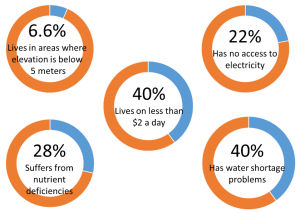Delivering on Paris: how the UK responds to its climate obligations
By ucqbpow, on 19 April 2018
Steve Pye, Francis Li, James Price
In a speech at the meeting of Commonwealth leaders in London on Tuesday, Claire Perry, the minister for Climate Change, announced that she would be seeking advice on strengthening UK climate targets, following publication in October this year of the Intergovernmental Panel on Climate Change (IPCC) Special Report on a 1.5°C warming limit.
This means that the Committee on Climate Change will revisit their analysis and recommendations on the implications of the Paris Agreement on the UK’s long term targets, first provided in 2016. In that report, they concluded that while ‘the Government has indicated it intends at some point to set a UK target for reducing domestic emissions to net zero,……… it is too early to do so now, but setting such a target should be kept under review.’It appears that a review is now imminent.
The CCC’s 2016 view, which was to maintain the status quo on ambition, was based on the need for more evidence on how the UK could achieve a net-zero target, and a prevailing view that the current 80% reduction framework was very ambitious and already represented a considerable challenge for government – thereby raising the question as to what could be gained from strengthening the target. Not a huge amount has changed in the last 18 months; for example, the challenge facing ministers to meet existing targets is evident, as demonstrated by the recent Clean Growth strategy failing to meet its own climate goals, and the policy gap identified by the CCC.
Shortly after the CCC gave its recommendations in 2016, we published a paper in Nature Energy (described in this Carbon Brief article) that explored this very question – what are the implications of the Paris Agreement for UK climate targets?We found that the UK energy system, which accounts for the vast majority of CO2emissions, would need to be carbon emissions free at some point in the 2045 to 2070 period under a 2°C target. The analysis also produced more stringent reduction trajectories than currently set out under the UK carbon budgets.
Making a more equitable contribution to global efforts, and pushing well below 2°C, both aspects which are embodied in the Paris Agreement, would require net-zero emissions by 2045. This means no oil use in our cars, an electricity system based wholly on renewables and nuclear, our homes heated by low carbon electricity or heat but not gas, and industry adopting new low carbon processes and energy.
The target year of 2045 is based on a UK allocated budget of 4 GtCO2from now until eternity. UK emissions are at around 420 MtCO2(including international transport), meaning that if current levels persisted, it would be around 10 years before this budget was used up.
Pursuing an even more ambitious 1.5°C target (which we did not consider in our 2017 paper) would mean leaving the UK with a 30% lower carbon budget than our most stringent 4 GtCO2case. Meeting this target would require truly heroic assumptions that may be difficult to envisage, given that the 2045 net-zero target in our study implied incredibly fast annual emission reductions of 9 %/year and eye-watering economic costs. Furthermore, we used optimistic assumptions on the role of CCS (and negative emissions technologies) which in effect increased the effective headroom available in the UK budget from 4 GtCO2 to 10 GtCO2. Furthermore, we assumed that long term transition policies could be put in place and maintained over time, unaffected by economic crises, social upheavals, or political backsliding on prior commitments, which may be viewed as ambitious assumptions indeed.
The fact that our analysis raised serious questions as to the feasibility of pursuing this type of goal means that proper scrutiny of higher long term ambition is crucial, in view of the science and with a full view of the possible options. And this reconsideration is timely; our paper made the point that to put in place the necessary policies now, we needed to be clear as to the longer term goal. Too little action or poor infrastructure choices in the near term puts climate goals at risk, without the time to take corrective action.
Reflecting on our paper, there are some important avenues for future investigation, to explore what longer term targets are needed, and the types of policies required to achieve them. Firstly, for those pathways that were feasible in our study, they typically were found to have had a significant contribution from CCS. The lack of serious policy consideration on CCS means that such pathways must be revisited, and alternatives explored that are more robust to any failure to scale future CCS deployment. A recent paper in Nature Climate Change offers some ideas in this direction.
Secondly, there needs to be more focus on the multiple options that might be available for reducing our end-use energy demand. This means testing options that are often omitted from models e.g. taxes on specific travel demands e.g. aviation, changes to urban planning that impact how we use energy, and the impact of technology on energy services e.g. mobility. And crucially, we need stronger scrutiny of the demand drivers going into models, which left unquestioned can lock us into higher emitting pathways but which may be fundamentally flawed. Another recent paper urges research in this direction.
Thirdly, and in view of the above, we urge efforts to take stock on what targets need to be achieved by when, in line with the spirit of the Paris Agreement. That means a UK net-zero target with a specific date attached, with this point in time reflecting the key principles of equity, the UK’s capacity to act as a leading G7 economy, and the science. The strength of such a target will be that it will serve to reduce ambiguity regarding when sectors need to achieve zero emissions, providing clarity to policy makers and investors.
As the CCC considers their advice towards the end of this year, there is a real opportunity to position the UK as a global leader in the debate on what actions countries can take to meet the extraordinary challenge agreed in Paris at COP21. Whatever is proposed, it will need to be followed up by a radical set of implementation policies to move beyond weighing our options and placing the UK firmly onto a net-zero pathway.
 Close
Close














